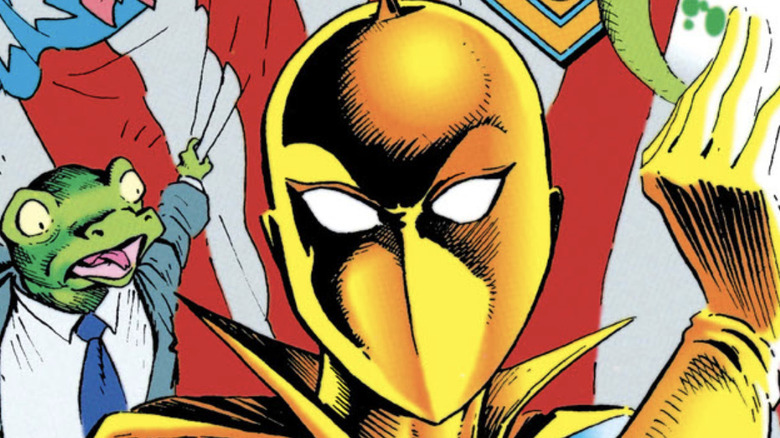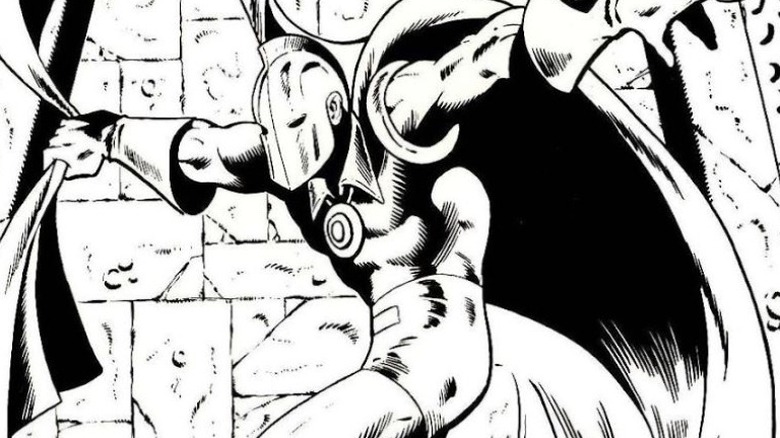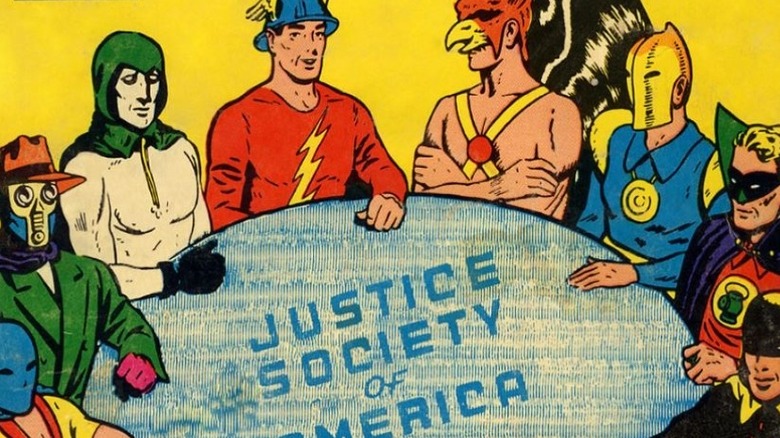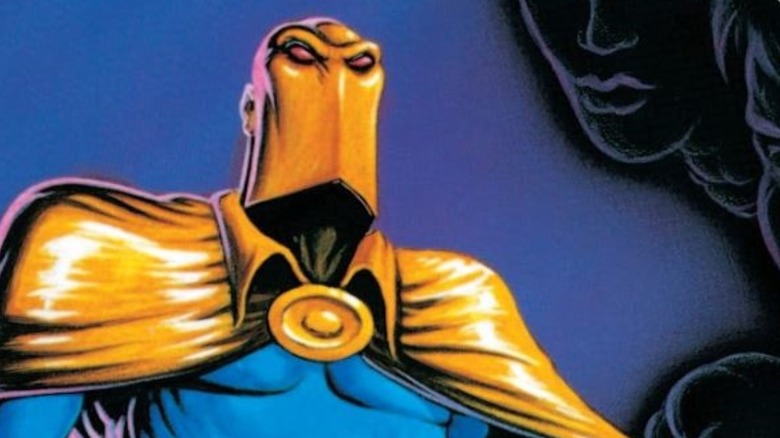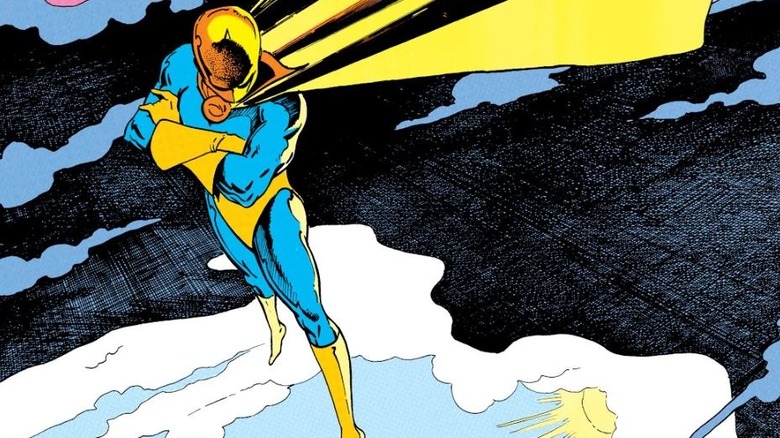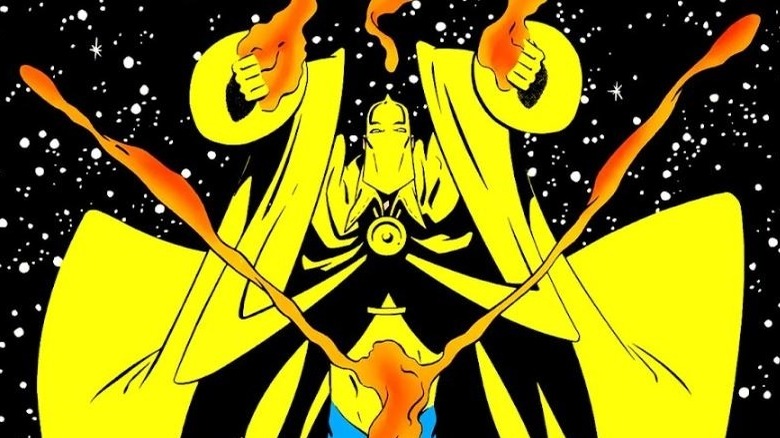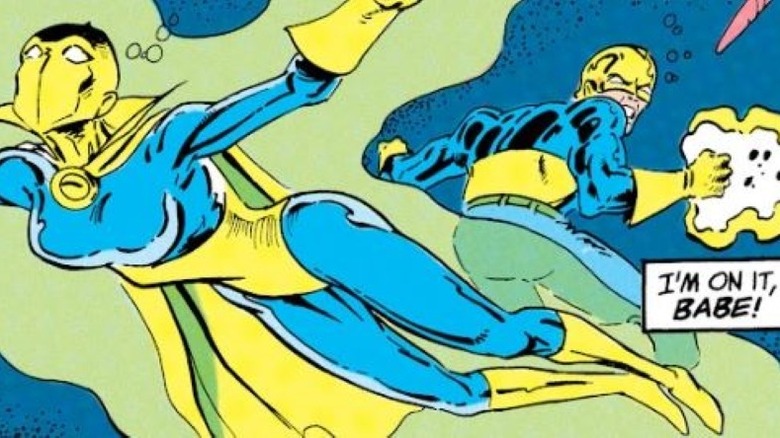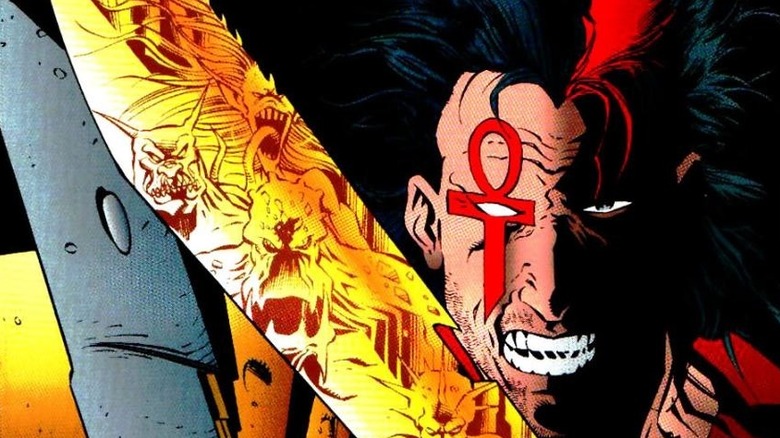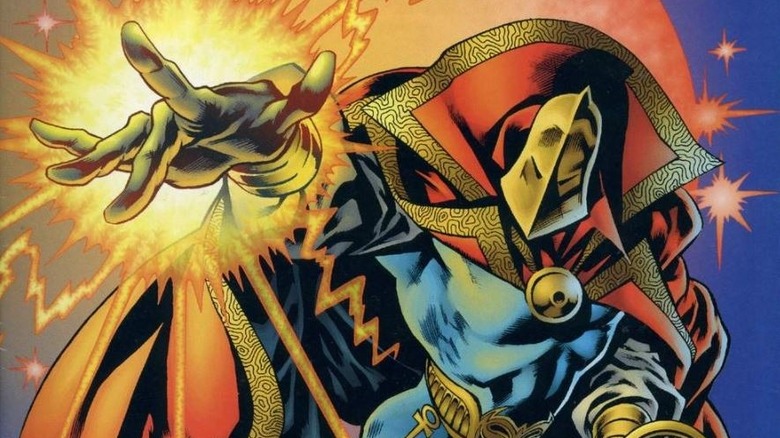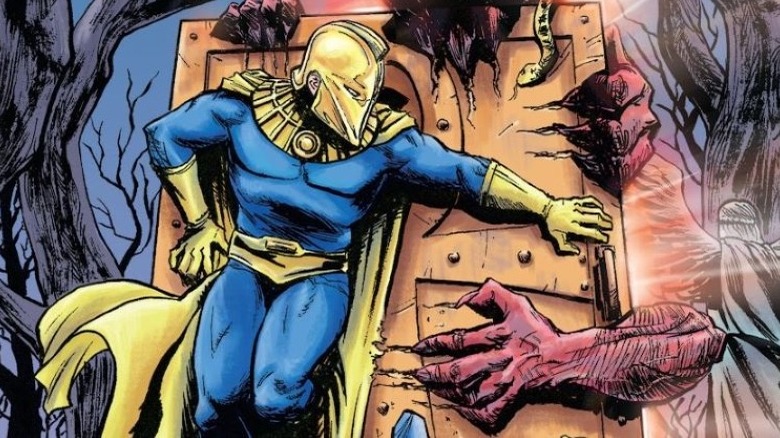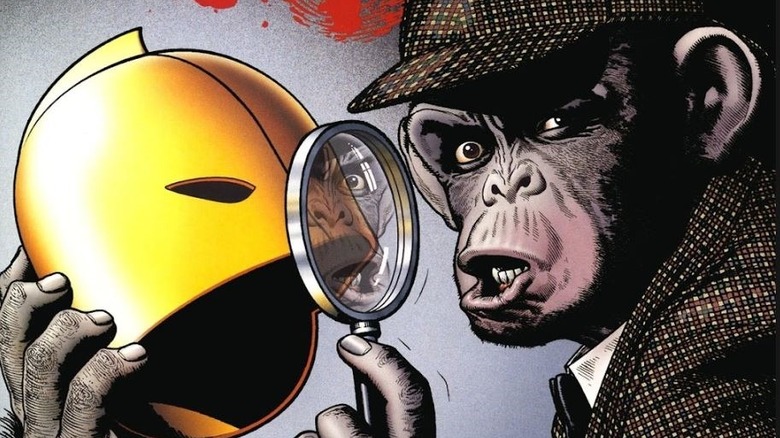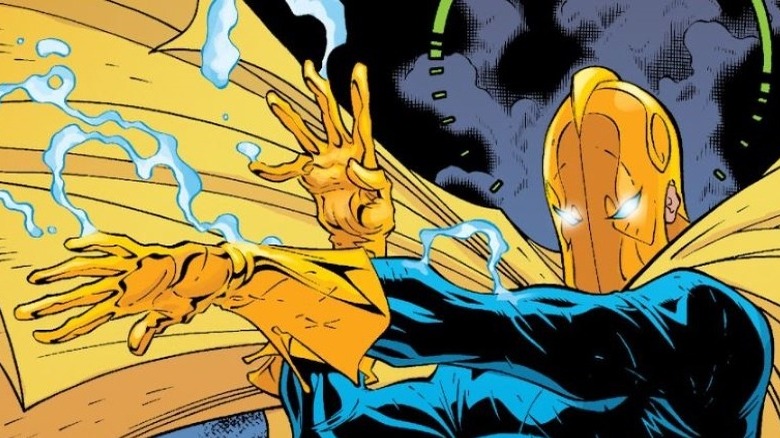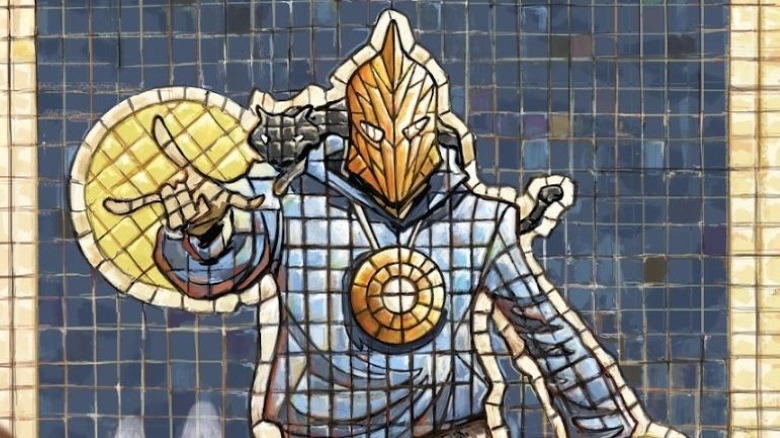DC's Doctor Fate: The 12 Most Memorable Comic Moments Ranked
A new magic-themed superhero has abracadabra-ed his way onto the big screen in Dwayne "The Rock" Johnson's comic book adaptation "Black Adam." Doctor Fate, played by Pierce Brosnan in the film, represents the mystical connection to DC's own version of the cinematic universe. Inescapably comparable to Marvel's resident wizard Doctor Strange, who has become a mainstay of the MCU since assisting in defeating Thanos, Doctor Fate could be called DC's own Sorcerer Supreme. However, while they fill similar roles in their respective franchises as masters of the mystic arts, the parallels end there.
As showcased in DC's anti-hero feature, "Black Adam," Doctor Fate is a different type of magical beast from his comic book brethren. Aside from being one of the media's first mystic-powered superheroes, Fate gains his powers from sporting an ancient Corinthian helmet which possesses properties and knowledge that grants its wearer magic abilities. So instead of training and studying for years, anyone can put on the Helmet of Fate and become a powerful sorcerer.
His potent abilities have made Doctor Fate's comic book history a thrilling one. As such, with "Black Adam" becoming a wide audience's first introduction to Doctor Fate, here's a breakdown of the integral moments in the character's long history in comic books.
First appearance of a new magical hero – More Fun Comics (1940)
Superheroes have been around for a long time — longer than you may think. Still, it was not until an alien from Krypton put on blue tights and a billowing cape in 1938 that comic book vigilantes exploded in popular culture. The aftermath of Superman's debut initiated the creation of hundreds of masked heroes in unique shapes, sizes, and colors. Doctor Fate is one example of the many heroes that blossomed in the formative years of superhero comic books. The first appearance of Kent Nelson, the first (and most recognizable) Doctor Fate, happened in "More Fun Comics" #55 from National Allied Publications, the predecessor of modern-day DC comics.
Created by writer Gardner Fox and illustrator Howard Sherman, Doctor Fate was wildly distinguishable from other superheroes of the time. His golden helmet separated him visually, while the stories introduced fantasy and mysticism to a crimefighting format. Conceptually, Fate was equally unique, gaining and learning his powers from a mystical patron, a Mesopotamian deity known as Nabu. By inhabiting the Helm of Fate, Kent Nelson could access Nabu's knowledge, energy, and thoughts; speaking with the magical entity, he essentially shared his body.
Formation of the Justice Society of America – All-Star Comics (1940)
Shortly following Fate's debut, the character joined forces with a collection of other comic book heroes to formulate the first superhero team, the Justice Society of America (JSA). Introduced in 1940's "All-Star Comics" #3, the original JSA roster put Doctor Fate at the table with The Flash, Green Lantern, The Spectre, Hawkman, Hourman, Sandman, and The Atom. Developed by Sheldon Mayer and Gardener Fox, the team-up did more than blend its characters; it originated the concept of giving comic book heroes a shared universe, a method later translated by Hollywood to create blockbuster crossovers like the MCU.
"[The JSA] was obviously a great notion," said comic historian Les Daniels in 2019, "since it offered readers a lot of headliners for a dime, and also the fun of watching fan favorites interact." Subsequently, superhero team-ups and crossovers became a mainstay for the print media, leading to the development of many comic book teams including JSA's successor, the Justice League. While the Justice League has become DC's principal super-team and included many reimagined variations of the JSA's original members, comic's first superhero team has been rectified in-universe as aged World War II-era superpowered veterans.
Doctor Fate's origin story – DC Special Series #10 (1980)
Despite the popularity of Doctor Fate and the JSA, "More Fun Comics" and "All-Star Comics" ended publication in the summer of 1944 as audience interest waned. For the most part, Fate and his compatriots virtually disappeared from comic books, making minor appearances in other DC titles until a short-lived resurgence in the mid-'70s.
As Doctor Fate floated around for decades without much exploration of his origins, the character received a re-introduction to modern audiences in the "DC Special Series" #10. The story solidified a backstory for Kent Nelson, which included meeting his mystical patriarch at the age of 12 and being transformed into adulthood. After learning the mystic arts from Nabu, Nelson's final test was to destroy his teacher's mortal form and capture his essence in the now-infamous Helm of Fate. This single issue would serve as Doctor Fate's canonical backstory going forward, giving the magical superhero new life in the modern era of print media and helping pave the way for JSA's return to the DC lineup.
Lead up to Crisis on Infinite Earths – All-Star Squadron (1981)
Beginning in 1981, Doctor Fate and his fellow JSA members would become regular mainstays in DC comics alongside the likes of Superman, Batman, and Wonder Woman. However, the timeline and continuity can get confusing.
The Justice Society of America finally made their way back to comic books with the arrival of the 1981 — 1987 "All-Star Squadron" title. The 67-issue comic series featured Doctor Fate and many other World War II-era heroes on new adventures. Although, instead of being a part of the same world as the Justice League, these tales occurred in a parallel reality known as Earth-2. Meanwhile, many of the characters crossed over with the Earth-1 heroes thanks to multidimensional travel. Thankfully, DC recognized how convoluted their comics were becoming and decided to sort out the roster with a ground-breaking crossover event in 1985, "Crisis on Infinite Earths."
Aside from being DC Comics' most influential large-scale crossover, "Crisis" helped shape the superhero universe for a new era — particularly as the series' release correlated with the end of the Bronze Age of Comics. The events of "Crisis on Infinite Earths" involved DC characters from across the multiverse coming together to defeat a single threat. The ramifications of the battle forced the heroes to blend their worlds into one Earth-Prime. For Doctor Fate and the JSA, they became all-but-forgotten heroes of old preceded by the modern-day heroes of the Justice League.
The complicated history of Eric and Linda Strauss – Doctor Fate (1987)
In 1987, Doctor Fate would finally receive his first self-titled comic book, starting with a four-part mini-series and followed up with an ongoing book the next year. However, the character of Kent Nelson was set aside, and a pair of new Doctor Fates would take the mantle.
A child of familial abuse and social anxiety, 10-year-old Eric Strauss was selected by the former mystic master as Nabu's new protégé. Like his successor, Eric was magically aged into adulthood and given the Helm of Fate. Unfortunately, despite having a better connection with his patron, the new Doctor Fate struggled to reach full power. The rookie superhero then discovered that he was destined to share the role of Doctor Fate with his stepmother Linda Strauss, and the pair would share the body of Kent Nelson.
As strange as the circumstance of a child and his stepmom sharing an old man's body sounds, it gets even more complicated; the duo developed romantic feelings for one another. Thankfully, the unsettling relationship wouldn't be given enough time to flourish, as Eric soon fell victim to the supervillain Desaad. Subsequently, Linda Strauss became the sole Doctor Fate — the first all-female version — and was a temporary member of Justice League International. However, by issue #24 of "Doctor Fate" Linda Strauss also died, making way for a new mystic master the following month.
Mr. and Mrs. Doctor Fate – Doctor Fate (1991)
By the time "Doctor Fate" issue #25 arrived in 1991, Kent Nelson was resurrected into a new, youthful body and ready to wear the all-powerful helmet once again. Except this time around, the mantle of Doctor Fate was to be shared with his wife Inza. Unfortunately for the veteran, Kent Nelson was unable to merge with his wife, leaving Inza Nelson the sole sorcerer for a time. As the new female Doctor Fate, Inza would become far more proactive and reckless with her abilities, leading to the discovery her patron is not Nabu but the evil Lord Chaos.
Forcing Lord Chaos to relinquish his power over Inza, she would continue to act as Doctor Fate. Although now Kent Nelson would fight alongside her, with both members of this marriage simultaneously serving as the magical doctor. Unfortunately, this variation of the mystical superhero was also short-lived. During DC's Zero Hour event, the two Doctor Fates fought along the JSA to defeat the supervillain Extant, resulting in the Nelsons becoming de-powered and their artifacts scattered, forcing them to retire.
Fate's extreme '90s makeover – Fate (1994)
The 1990s were an ambitious time for comic books. A bump in popularity and collecting resulted in publishing companies pulling out all the stops for their characters. Some of the most popular superheroes were being killed off and redesigned. The tone of the industry was shifting into darker territory. And for some reason, heroes were getting more pockets and pouches than they knew what to do with. Even Doctor Fate fell prey to such rampant re-imaginings, with one of the most outrageous character designs of the memorable decade.
As told in 1994's "Fate" #0, the aged and retired Nelsons enlisted the help of smuggler Jared Stevens to assist them in procuring their lost artifacts. However, when the two former heroes are murdered, Stevens attempts to use their amulet as a weapon, but it explodes and embeds its magical powers into him. With a scarred face and refusing to become the new Doctor Fate, Stevens rebrands himself as "Fate" and melts down the mighty helmet, reforging it into a set of darts and a golden dagger. Serving better as a demon hunter than a spellcaster, this incarnation was not received well and was short-lived. Still, it is such an outlandish reinvention that "Fate" has remained essential reading for any fan.
A Marvel Amalgamation – Doctor Strangefate (1996)
In what is likely the most underrated moment in comic book history, the most popular publishers in comics crossed over to blend their characters into a 24-issue collection of one-shot titles under the fictional banner Amalgam Comics. Although temporary, Marvel and DC managed to put their differences aside and create an all-new comic book universe that featured the best of both franchises. A couple of the best characters included a Wolverine-Batman blend called Dark Claw, and Spider-Boy, a mix between Spider-Man and Super Boy.
The Amalgam Universe had its own backstory involving this alternate reality at the center of a cataclysmic event, and even the comic books were treated as if they had been in print for many years. At the center of the conflict was one character who vowed to preserve the blended universe and act as its protector: Doctor Strangefate. A crossover of Doctor Strange and Doctor Fate, the biggest reveal was that X-Men founder Charles Xavier was under the helmet. Although Doctor Strangefate and the rest of the Amalgam Universe were a hit with fans, the crossover only lasted two glorious years.
The ephemeral Hector Hall – JSA (2002)
If you thought the history of Doctor Fate was complicated, wait until you meet Hector Hall. The son of the original Hawkman and Hawkgirl, Hector considered himself destined to become a superhero. Born without powers, the would-be hero fashioned a suit out of Nth metal (a material used by his parents that grants flight) and gave himself the title Silver Scarab. Along with a group of novice heroes, Hector helped form Infinity Inc., a junior club to the JSA.
Unfortunately, for the Silver Scarab, his tenure would not last long, as he seemingly died. But in actuality, he was trapped in the dream dimension, where he took on the mantle of Sandman. Again not lasting long, Hector eventually ended up in the realm of the dead, yet thanks to inheriting a reincarnation cycle from his biological parents, he came back to life. Fittingly, the character who was searching for a substantial identity coincided with a superhero title that had gone through multiple custodians, and when Hector became the new Doctor Fate, well, it just made sense. However, like many wearers of the Helm of Fate before him, Hector's run as the new mystic master met with disaster after a short run.
The Helmet of Fate's journey through the universe – The Helmet of Fate (2007)
When it came time again in 2007 for DC Comics to find a new Doctor Fate, they went all out. The "Helmet of Fate" series promised to not only find a new head for the magical Helm of Fate, but also to explore its impact across the entire DC Universe.
The mini-series includes five unique one-shot issues featuring a different magic user from different corners of the galaxy. At this point, the artifact is once again imbued with the powers and consciousness of Nabu, as he searches for a new patriarch amongst characters like Detective Chimp, Ibis the Invincible, Sargon the Sorcerer, Black Alice, and Zauriel.
Each issue of the "Helmet of Fate" series was penned by a different creative team, offering unique perspectives of the powerful antique. Encountering a varied selection of DC's magic users introduced the impact that the magical antique holds on the mystical realm of the comic books. Ultimately, the mini-series was intended to steer into a new ongoing series featuring the newly-crowned Doctor Fate. However, real-world destiny would change the direction of the helmet — and the superhero.
Countdown to Mystery's alternate endings – Countdown to Mystery (2007)
One of the star comic writers included in the "Helmet of Fate" series was the legendary creator of Howard the Duck, Steve Gerber. With over 30 years of experience, fans were excited to know that Gerber signed on to helm the brand-new Doctor Fate ongoing series. Unfortunately, following the announcement, Gerber was diagnosed with idiopathic pulmonary fibrosis and passed away. From a hospital bed, the famed writer wanted to share his story of Doctor Fate so badly that he created an eight-issue limited series, yet he was only able to finish the first seven chapters of "Countdown to Mystery."
In Gerber's honor, four separate writers created their own version of the concluding chapter. Adam Beechen, Mark Evanier, Gail Simone, and Mark Waid each posited a unique ending to Gerber's last story, creating a stand-out series with alternate endings. Meanwhile, Gerber did manage to introduce his new Doctor Fate, Kent V. Nelson, the grand nephew of the original magic bearer. As a Justice Society of America member, this variation of Fate had a successful career and managed to train his predecessor before his own demise.
The Blood Price – Doctor Fate (2015)
The latest incarnation of Doctor Fate was introduced in 2015. With a new self-titled ongoing series, Khalid Nassour became DC's newest sorcerer supreme with a fresh take on the classic superhero.
As one of the publishing company's first Muslim heroes, Nassour gains his powers from a different patron than Nabu, instead connecting with the Egyptian deity Hauhet. Inspired by Marvel's Spider-Man comics, the new Doctor Fate begins as a young, untrained, and witty character, making his books light-hearted and enjoyable to read. Under the tutelage of the former Fate, Kent V. Nelson, Nassour has become a premiere magic user in the DC continuum.
Khalid Nassour's introductory story, "The Blood Price," kicks off the fourth "Doctor Fate" title. Hilariously, this modernized character is a medical student, which would eventually make him the first actual doctor in the long line of Doctor Fates. The new series is celebrated for breathing life into a character that has gone through so many redesigns. However, if you become attached to Nassour, do so with caution, considering how ephemeral bearers of the Helmet of Fate have been throughout the character's storied history.
